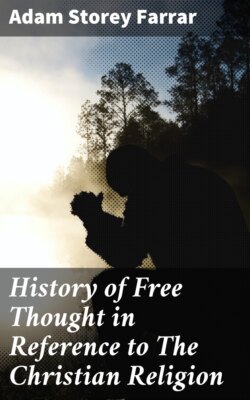Читать книгу History of Free Thought in Reference to The Christian Religion - Adam Storey Farrar - Страница 6
На сайте Литреса книга снята с продажи.
Lecture III.
ОглавлениеTable of Contents
Free Thought during the middle ages, and at the Renaissance; together with its rise in modern times.
This period embraces the second and third of the four epochs of doubt, and the commencement of the fourth. Brief outline of the events which it includes. (pp. 75, 76.)
Second crisis, from A.D. 1100–1400. (pp. 76–92.) It is a struggle political as well as intellectual, Ghibellinism as well as scepticism. (p. 76.)
The intellectual tendencies in this period are four:
1. The scepticism developed in the scholastic philosophy, as seen in the Nominalism of Abélard in the twelfth century. Account of the scholastic philosophy, pp. 77–80; and of Abélard as a sceptic in his treatise Sic et Non. (pp. 81–85.) 2. The mot of progress in religion in the Franciscan book called The Everlasting Gospel in the thirteenth century. (pp. 86, 87.) 3. The idea of the comparative study of religion, as seen in the legend of the book De Tribus Impostoribus in the thirteenth century; and in the poetry of the period. (pp. 88, 89.) 4. The influence of the Mahometan philosophy of Averroes in creating a pantheistic disbelief of immortality. (pp. 90, 91.)
Remarks on the mode used to oppose these movements; and critical estimate of the period. (pp. 91, 92.)
Third crisis, from 1400–1625. (pp. 93–105.) Peculiarity of this period as the era of the Renaissance and of “Humanism,” and as the transition from mediæval society to modern. (p. 93.)
Two chief sceptical tendencies in it:
(1) The literary tendency in Tuscany and Rome in the fifteenth century; the dissolution of faith being indicated by (a) the poetry of the romantic epic. (p. 94.) (b) the revival of heathen tastes. (p. 95.)
Estimate of the political and social causes likely to generate doubt, which were then acting. (pp. 97, 98.) the unbelief was confined to Italy.—Reasons why so vast a movement as the Reformation passed without fostering unbelief. (p. 99.)
[pg xxxv]
2. The philosophical tendency in the university of Padua in the sixteenth century. (p. 99 seq.) The spirit of it, pantheism (p. 100), in two forms; one arising from the doctrines of Averroes; the other seen in Pomponatius, from Alexander of Aphrodisias. (p. 101.) The relation of other philosophers, such as Bruno and Vanini, to this twofold tendency. (pp. 102–104.)
Remarks on the mode used to oppose doubt (p. 104); and estimate of the crisis. (p. 105.)
Fourth crisis; (pp. 105–339) commencing in the seventeenth century, through the effects of the philosophy of Bacon and Descartes. (p. 106.)
The remainder of the lecture is occupied with the treatment of the influence of Cartesianism, as seen in Spinoza.
Examination of Spinoza's philosophy (pp. 106–110); of his criticism in the Theologico-Politicus (pp. 109–113); and of his indirect influence. (p. 113, 114.)
Concluding remarks on the government of Providence, as witnessed in the history of large periods of time, such as that comprised in this lecture. (p. 115.)
